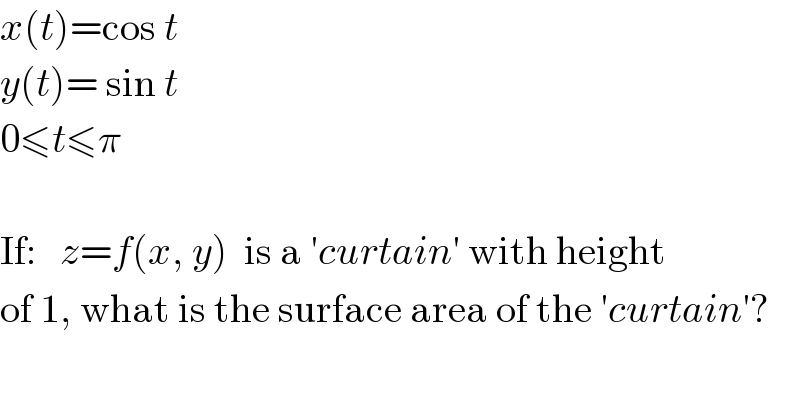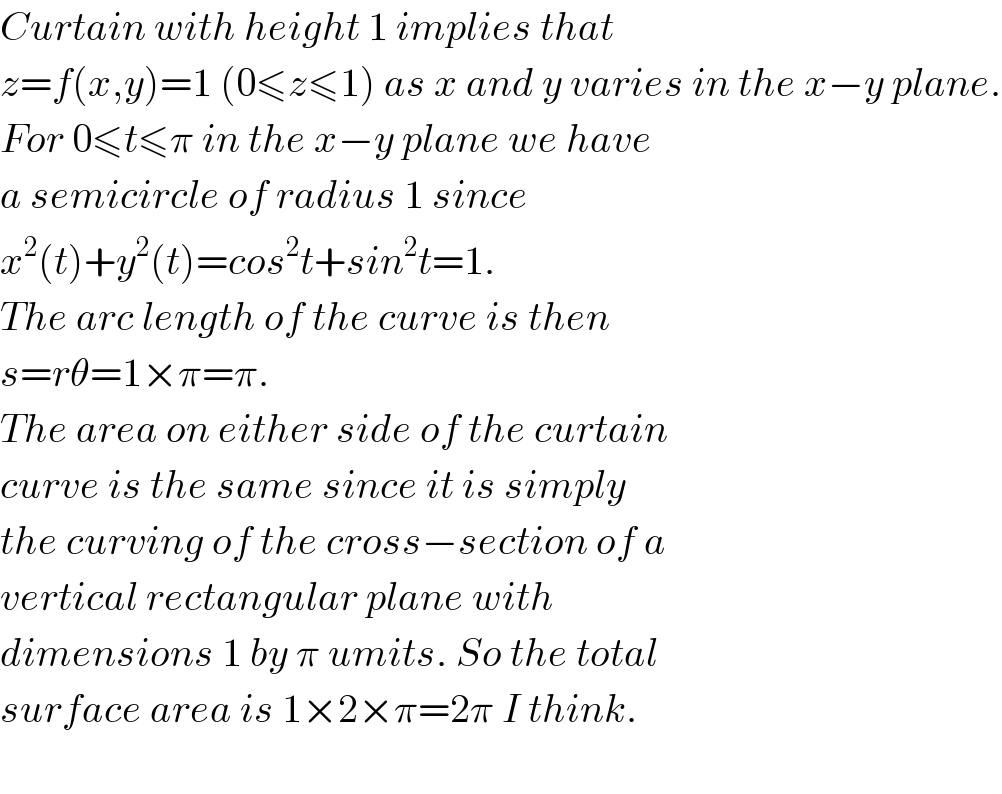
Question Number 2491 by Filup last updated on 21/Nov/15

$${x}\left({t}\right)=\mathrm{cos}\:{t} \\ $$$${y}\left({t}\right)=\:\mathrm{sin}\:{t} \\ $$$$\mathrm{0}\leqslant{t}\leqslant\pi \\ $$$$ \\ $$$$\mathrm{If}:\:\:\:{z}={f}\left({x},\:{y}\right)\:\:\mathrm{is}\:\mathrm{a}\:'{curtain}'\:\mathrm{with}\:\mathrm{height}\: \\ $$$$\mathrm{of}\:\mathrm{1},\:\mathrm{what}\:\mathrm{is}\:\mathrm{the}\:\mathrm{surface}\:\mathrm{area}\:\mathrm{of}\:\mathrm{the}\:'{curtain}'? \\ $$
Commented by Yozzi last updated on 21/Nov/15

$${Curtain}\:{with}\:{height}\:\mathrm{1}\:{implies}\:{that} \\ $$$${z}={f}\left({x},{y}\right)=\mathrm{1}\:\left(\mathrm{0}\leqslant{z}\leqslant\mathrm{1}\right)\:{as}\:{x}\:{and}\:{y}\:{varies}\:{in}\:{the}\:{x}−{y}\:{plane}. \\ $$$${For}\:\mathrm{0}\leqslant{t}\leqslant\pi\:{in}\:{the}\:{x}−{y}\:{plane}\:{we}\:{have} \\ $$$${a}\:{semicircle}\:{of}\:{radius}\:\mathrm{1}\:{since}\: \\ $$$${x}^{\mathrm{2}} \left({t}\right)+{y}^{\mathrm{2}} \left({t}\right)={cos}^{\mathrm{2}} {t}+{sin}^{\mathrm{2}} {t}=\mathrm{1}. \\ $$$${The}\:{arc}\:{length}\:{of}\:{the}\:{curve}\:{is}\:{then}\: \\ $$$${s}={r}\theta=\mathrm{1}×\pi=\pi. \\ $$$${The}\:{area}\:{on}\:{either}\:{side}\:{of}\:{the}\:{curtain} \\ $$$${curve}\:{is}\:{the}\:{same}\:{since}\:{it}\:{is}\:{simply} \\ $$$${the}\:{curving}\:{of}\:{the}\:{cross}−{section}\:{of}\:{a} \\ $$$${vertical}\:{rectangular}\:{plane}\:{with}\: \\ $$$${dimensions}\:\mathrm{1}\:{by}\:\pi\:{umits}.\:{So}\:{the}\:{total} \\ $$$${surface}\:{area}\:{is}\:\mathrm{1}×\mathrm{2}×\pi=\mathrm{2}\pi\:{I}\:{think}. \\ $$$$ \\ $$
Answered by Yozzi last updated on 21/Nov/15

$${S}.{A}=\mathrm{2}\pi.\:{This}\:{answer}\:{assumes}\:{that} \\ $$$${the}\:{areas}\:{on}\:{the}\:{edges}\:{of}\:{the}\:{curtain} \\ $$$${are}\:{all}\:{negligible}.\: \\ $$
